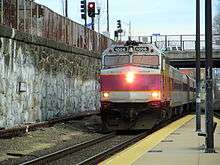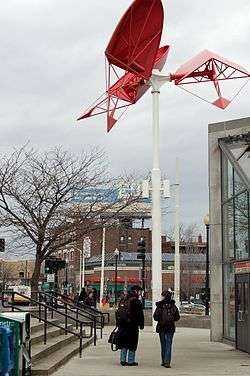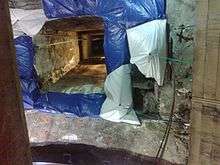Porter (MBTA station)
PORTER
PORTER | ||||||||||||||||||||||||||||||
|---|---|---|---|---|---|---|---|---|---|---|---|---|---|---|---|---|---|---|---|---|---|---|---|---|---|---|---|---|---|---|
|
A Red Line train at Porter on the lower (outbound) platform | ||||||||||||||||||||||||||||||
| Location | Massachusetts Avenue at Somerville Avenue, Cambridge, Massachusetts | |||||||||||||||||||||||||||||
| Coordinates | 42°23′18.0″N 71°07′08.5″W / 42.388333°N 71.119028°WCoordinates: 42°23′18.0″N 71°07′08.5″W / 42.388333°N 71.119028°W | |||||||||||||||||||||||||||||
| Owned by | Massachusetts Bay Transportation Authority | |||||||||||||||||||||||||||||
| Line(s) | ||||||||||||||||||||||||||||||
| Platforms |
1 island platform (Fitchburg Line) 2 split platforms (Red Line) | |||||||||||||||||||||||||||||
| Tracks |
2 (Fitchburg Line) 2 (Red Line) | |||||||||||||||||||||||||||||
| Connections |
| |||||||||||||||||||||||||||||
| Construction | ||||||||||||||||||||||||||||||
| Parking | None | |||||||||||||||||||||||||||||
| Bicycle facilities | 34 spaces | |||||||||||||||||||||||||||||
| Disabled access | Yes | |||||||||||||||||||||||||||||
| Other information | ||||||||||||||||||||||||||||||
| Fare zone | 1A (commuter rail) | |||||||||||||||||||||||||||||
| History | ||||||||||||||||||||||||||||||
| Opened |
1845 (Fitchburg Railroad) December 8, 1984 (Red Line)[1] | |||||||||||||||||||||||||||||
| Rebuilt | 1897, 1937 | |||||||||||||||||||||||||||||
| Previous names | Porter's Station, North Cambridge, Cambridge | |||||||||||||||||||||||||||||
| Traffic | ||||||||||||||||||||||||||||||
| Passengers (2012) | 1,616 daily boardings[2] (Fitchburg Line) | |||||||||||||||||||||||||||||
| Passengers (2013) | 8,850 daily boardings[3] (Red Line) | |||||||||||||||||||||||||||||
| Services | ||||||||||||||||||||||||||||||
| ||||||||||||||||||||||||||||||
Porter is an MBTA transfer station serving the rapid transit Red Line and the commuter rail Fitchburg Line, located at Porter Square in Cambridge, Massachusetts. Positioned at the intersection of Massachusetts and Somerville Avenues, the station provides rapid transit access to northern Cambridge and the western portions of Somerville.[4] Porter is 14 minutes from Park Street on the Red Line, and about 10 minutes from North Station on commuter rail trains.[4] Several local MBTA Bus routes also stop at the station.
A series of commuter rail depots have been located at Porter Square under various names since the 1840s. The modern station with both subway and commuter rail levels was designed by Cambridge Seven Associates and opened on December 8, 1984. At 105 feet (32 m) below ground, the subway section is the deepest station on the MBTA system.[5] The station originally had six artworks installed as part of the Arts on the Line program; five remain, including Gift of the Wind and Glove Cycle.
History
Early history
There has been a railroad station at Porter Square since the Fitchburg Railroad began operations in the early 1840s. The first station, built in 1843–45, was called Porter's Station.[6] Later stations at the site were known as North Cambridge, then later simply as Cambridge.[7] In 1869, the original station was moved to the North Avenue (now Massachusetts Avenue) bridge over the tracks.[6]
B&M era
A new station was built in 1897, slightly to the southeast, behind the Lovell Block. In 1927, the Fitchburg Cutoff became freight-only between the Alewife area and Somerville Junction. Passenger trains from the Lexington Branch and the Central Massachusetts Railroad were diverted to the Fitchburg mainline and began to stop at Cambridge station.[8] In 1937, the Boston and Maine Railroad built a two-story brick depot by the bridge, with the ticket office at street level and the waiting room and platforms below.[9]
MBTA era
By the time the newly formed Massachusetts Bay Transportation Authority began subsidizing northside commuter rail operations in the late 1960s, both the Lexington Branch and the Central Mass Branch had been reduced to single rush hour round trips on poorly maintained track. The South Sudbury run on the Central Mass was terminated on November 26, 1971.[1] The Bedford round trip on the Lexington Branch ended after a major snowstorm on January 10, 1977, leaving the Fitchburg Line (with multiple daily round trips) as the only rail service at Cambridge station.[1]
Adding the Red Line
In the late 1970s, Cambridge station was renamed to Porter when it became certain that the Red Line Northwest Extension would include a stop there. ("Cambridge", while sufficient for a commuter-rail station, would have been confusing for a rapid-transit station, because the Red Line has multiple stations—five in total—in the City of Cambridge.) The Red Line platforms were built in a deep-bore tunnel, while the commuter platform was rebuilt with an accessible mini-high platform. During construction, commuter trains were accessed via a still-extant staircase from Somerville Avenue.[10]
A new glass and concrete headhouse was built around 1982, and the complete new transfer station opened on December 8, 1984 along with the renovated Harvard station and the new Davis station.[1][9] The new station, designed by Cambridge Seven Associates, won awards from the American Institute of Architects and the American Consulting Engineering Council of New England.[5]
Because of its Red Line connection, Porter Square can serve as a temporary inbound terminus for the Fitchburg Line service when commuter rail service is disrupted between Porter and Boston's North Station. It served this role during the 2004 Democratic National Convention, when North Station was closed for a week for security purposes, and during Green Line Extension construction in 2015.[1][11]
Station layout

| G | Street Level | Exit/Entrance |
| B1 Fitchburg Line platform |
Commuter rail track | ← Fitchburg Line → |
| Island platform, doors will open on the left, right | ||
| Commuter rail track | ← Fitchburg Line → | |
| B2 | Mezzanine | Fare mezzanine, crossover, escalators to commuter platforms and exits/entrances |
| B3 Upper platform |
Inbound | → ← Red Line toward Ashmont or Braintree (Harvard) |
| Side platform, doors will open on the left | ||
| B4 Lower platform |
Side platform, doors will open on the left | |
| Outbound | Red Line toward Alewife (Davis) → | |
The subway station at Porter is, at 105 feet below ground level, the deepest in the MBTA system.[5] Porter's unusual depth is due to the MBTA's decision to build the station in bedrock rather than soft clay, saving time and money in the construction process.[12] Passengers reach Red Line platforms via a series of escalators, stairs totalling 199 steps, or a set of elevators. The longest single span of the escalators is 143 feet, the longest in the MBTA system.[4][12] In 2005, a man was killed when his sweatshirt tangled in the bottom of the escalator.[13]
The subway tracks and platforms are enclosed in a single cylindrical concrete shell, similar to most underground stations of the Washington Metro. The two platforms are at different levels, with portions of the inbound platform projecting over the outbound platform. Both tracks are on the outer side of their platforms. On the MBTA subway network, only State, North Station, and Harvard have similar split platforms. (Several downtown transfer stations have multiple platform levels, but these are the only four with multiple-level platforms for a single line.)
Porter has five levels: the street-level entrances, the below-grade commuter platforms, the fare mezzanine, and two subway platform levels underground.
Porter has a refreshment vendor outside the fare gates on the mezzanine level, and, unlike most MBTA stations, public restrooms.[14]
Arts on the Line

As a part of the Red Line Northwest Extension, Porter was included as one of the stations involved in the Arts on the Line program, devised to bring art into the MBTA's subway stations in the late 1970s and early 1980s. It was the first program of its kind in the United States and became the model for similar drives for art across the country.[15]:5
Six works, five of which remain, were placed at Porter:
- Gift of the Wind by Susumu Shingu, a 46-foot tall kinetic sculpture with three large red "wings" that rotate the structure in response to the wind
- Ondas by Carlos Dorrien, a 24-foot tall piece of undulating granite affixed to the station wall both inside the station and outside
- Glove Cycle by Mags Harries, a large number of bronze gloves of varying types and sizes scattered inside the station, including alongside one of the escalators
- Untitled by William Reimann, six granite bollards with various ethnic designs carved into them
- Porter Square Megaliths by David Phillips, four boulders with large "slices" removed and replaced with bronze casts of the missing pieces
- The Lights at the End of the Tunnel by William Wainwright, a large reflective mobile in the station's mezzanine. It was removed in 1986 after a lead weight fell off.[15]:9[16]
Accessibility

Porter is fully handicapped accessible; elevators lead from street level to the mezzanine with its accessible bathroom, to the commuter rail platform, and to both Red Line platform levels. Although most of the commuter platform is low, there is a "mini-high platform" - a one car-length high section - that allows level boarding.
As a result of a 2006 settlement of a lawsuit filed by the Boston Center for Independent Living and a group of individuals, the MBTA installed additional elevators at Porter and four other busy MBTA subway stations.[14] The elevator to the Red Line was out of service for 15 months beginning in March 2011 for car replacement and the installation of a second, redundant, elevator. An accessible shuttle bus ran between Porter and Davis.[14]
The elevator to the commuter rail platform was also temporarily out of service for maintenance during the same period; a shuttle bus ran between Harvard, Porter and Waltham.[17] The Red Line elevator was returned to service on June 22, 2012, and the commuter rail elevator returned to service on July 30, 2012.[18]
Bus connections
Porter serves several MBTA Bus local routes via shelters on Massachusetts Avenue and Somerville Avenue:
- 77 Arlington Heights - Harvard Station via Massachusetts Avenue
- 83 Rindge Ave. - Central Square, Cambridge via Porter Square Station
- 96 Medford Square - Harvard Station via George Street & Davis Square Station
The 77 and 96 run on Massachusetts Avenue, while the 83 turns from Somerville Avenue to Massachusetts Avenue at Porter Square. Additionally, the 87 Arlington Center or Clarendon Hill - Lechmere Station via Somerville Avenue bus stops on Elm Street at the Porter Square Shopping Center, one block northeast of Porter station.[19]
The 77A short turn of the 77 operates as a trolleybus on a limited number of runs, as trolleybuses on other routes are brought to and from the North Cambridge Carhouse.[1]
References
- 1 2 3 4 5 6 Belcher, Jonathan (31 December 2011). "Changes to Transit Service in the MBTA district" (PDF). NETransit. Retrieved 23 March 2012.
- ↑ Humphrey, Thomas J. (21 December 2012). "MBTA Commuter Rail Passenger Count Results" (PDF). Boston Region Metropolitan Planning Organization. Retrieved 10 August 2015.
- ↑ "Ridership and Service Statistics" (PDF) (14 ed.). Massachusetts Bay Transportation Authority. 2014. Retrieved 28 July 2014.
- 1 2 3 "Red Line" (PDF). Massachusetts Bay Transportation Authority. Archived from the original (PDF) on 16 May 2013.
- 1 2 3 "MBTA Porter Square Station". Cambridge Seven Associates. Retrieved 21 March 2013.
- 1 2 Survey of Architectural History in Cambridge: Northwest Cambridge. Cambridge Historical Commission. 1977. pp. 138–140. ISBN 0-262-53032-5.
- ↑ The station is listed as "North Cambridge" on 1871 and 1898 maps and "Cambridge" on 1888, 1916, and 1975 maps from Wikimedia Commons.
- ↑ Karr, Ronald Dale (1995). The Rail Lines of Southern New England. Branch Line Press. p. 228. ISBN 0-942147-02-2.
- 1 2 Roy, John H. Jr. (2007). A Field Guide to Southern New England Railroad Depots and Freight Houses. Branch Line Press. pp. 184–186. ISBN 978-0-942147-08-7.
- ↑ Prescott, Michael R. (11 October 2009). Boston Transit Equipment 1979–2009. Boston Street Railway Association. p. 49. ISBN 978-0-938315-06-3.
- ↑ "Commuter Rail Service Alerts: Fitchburg Line". Massachusetts Bay Transportation Authority. 25 November 2015. Archived from the original on 30 November 2015.
- 1 2 Daniel, Mac (June 11, 2006). "Odd road sign is part of Boston trivia". Boston Globe. Retrieved 27 March 2012.
- ↑ Daniel, Mac (2 March 2005). "Man is strangled after clothing snags in MBTA escalator". Boston Globe. Retrieved 29 March 2012.
- 1 2 3 Parker, Brock (16 March 2011). "Work to shut down elevators at Porter Sq. T stop for a year". Boston Globe. Retrieved 26 March 2012.
- 1 2 Massachusetts Bay Transportation Authority (3 May 1985). Red Line Northwest Extension. Retrieved 10 August 2015.
- ↑ "The Lights at the End of the Tunnel". CultureNOW. Retrieved 10 August 2015.
- ↑ "MBTA DEPARTMENT OF SYSTEM-WIDE ACCESSIBILITY FIXED ROUTE REPORT" (PDF). Boston Region Metropolitan Planning Organization. December 2011. Retrieved 26 March 2012.
- ↑ Rocheleau, Matt (22 June 2012). "Elevator access returns to Porter Square T station after 15-month absence". Boston Globe. Retrieved 23 June 2012.
- ↑ "Porter Station Neighborhood Map" (PDF). Massachusetts Bay Transportation Authority. March 2015. Retrieved 17 August 2015.
External links
| Wikimedia Commons has media related to Porter (MBTA station). |
- MBTA: Porter Commuter Rail and Red Line
- Porter station on Google Maps Street View: Main headhouse, secondary entrance from Massachusetts Avenue. Somerville Avenue entrance